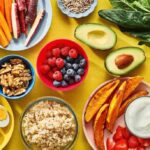7 Healthy Foods for Kids: Ensuring your kids get the right nutrients can be a daily challenge. With picky eaters and busy schedules, finding foods that are both healthy and appealing can feel like an uphill battle. But don’t worry! Here’s a list of seven superfoods that will keep your kids strong, energized, and ready to conquer the world—one playground at a time.
7 Healthy Foods for Kids
1. Oatmeal
Oatmeal is a fantastic way to start the day. Packed with fiber, it keeps kids full and focused until lunch. Plus, it’s versatile! Add fruits, nuts, or a drizzle of honey for a burst of flavor.
Nutritional Benefits:

| Nutrient | Amount per 1 Cup | % Daily Value* |
|---|---|---|
| Fiber | 4g | 16% |
| Protein | 6g | 12% |
| Iron | 2mg | 10% |
*Based on a 2,000-calorie diet.
How to Serve: Top with sliced bananas, a sprinkle of cinnamon, or a spoonful of peanut butter.
2. Yogurt
Yogurt is rich in calcium, which is crucial for growing bones. It also contains probiotics that aid digestion. Choose plain, low-fat yogurt and sweeten it with fresh fruit or a touch of honey to avoid added sugars.
Nutritional Benefits:
| Nutrient | Amount per 1 Cup | % Daily Value* |
|---|---|---|
| Calcium | 300mg | 30% |
| Protein | 8g | 16% |
| Probiotics | Varies | – |
How to Serve: Mix with berries and a dash of granola for a fun and crunchy treat.
3. Eggs
Eggs are a powerhouse of nutrients, offering protein, healthy fats, and a range of vitamins. They’re also super versatile—scrambled, boiled, or baked into muffins, there’s something for every kid.
Nutritional Benefits:
| Nutrient | Amount per 1 Large Egg | % Daily Value* |
|---|---|---|
| Protein | 6g | 12% |
| Vitamin D | 1.1mcg | 5% |
| Choline | 147mg | 27% |
How to Serve: Make an egg sandwich, or whip up an omelet with their favorite veggies.
4. Avocados

Avocados are rich in healthy fats and fiber, making them perfect for growing bodies and active brains. Plus, their creamy texture is often a hit with kids.
Nutritional Benefits:
| Nutrient | Amount per 1/2 Avocado | % Daily Value* |
|---|---|---|
| Healthy Fats | 10g | – |
| Fiber | 5g | 20% |
| Potassium | 345mg | 8% |
How to Serve: Spread on whole-grain toast, mash into guacamole, or blend into a smoothie.
5. Carrots
Carrots are not just for bunnies! These crunchy, sweet veggies are packed with beta-carotene, which is converted into vitamin A, essential for good vision and immune function.
Nutritional Benefits:
| Nutrient | Amount per 1 Medium Carrot | % Daily Value* |
|---|---|---|
| Vitamin A | 509mcg | 57% |
| Fiber | 1.7g | 7% |
| Vitamin K | 8mcg | 7% |
How to Serve: Serve raw with hummus, or roast them for a sweeter flavor.
6. Salmon
Salmon is an excellent source of omega-3 fatty acids, which support brain development and function. It’s also high in protein, making it great for muscle growth.
Nutritional Benefits:
| Nutrient | Amount per 3oz Cooked | % Daily Value* |
|---|---|---|
| Omega-3 Fats | 1,000mg | – |
| Protein | 19g | 38% |
| Vitamin B12 | 2.4mcg | 40% |
How to Serve: Grill and serve with rice, or mix into pasta with a light cream sauce.
7. Berries
Berries, like strawberries, blueberries, and raspberries, are antioxidant powerhouses. They help fight free radicals in the body, protecting cells and boosting the immune system.
Nutritional Benefits:
| Nutrient | Amount per 1 Cup (Mixed Berries) | % Daily Value* |
|---|---|---|
| Vitamin C | 85mg | 94% |
| Fiber | 8g | 32% |
| Antioxidants | High | – |
How to Serve: Add to yogurt, blend into smoothies, or just serve them fresh as a snack.
Key Takeaways
- Balanced nutrition is crucial for kids’ growth, energy, and overall health.
- Variety is key—introduce different foods to keep meals exciting and nutrient-rich.
- Presentation matters—get creative with how you serve healthy foods to make them more appealing to kids.
FAQs
Q: How can I get my picky eater to try these foods?
A: Start by introducing small portions and mixing them with their favorite foods. Gradually increase the amount as they get used to the taste.
Q: Are these foods suitable for all ages?
A: Yes, these foods are generally suitable for kids of all ages. However, portion sizes should be adjusted based on their age and nutritional needs.
Q: What if my child has a food allergy?
A: If your child has a food allergy, substitute with similar alternatives. For example, if they’re allergic to eggs, try chia seeds or tofu as a protein source.
By incorporating these seven healthy foods into your kids’ diet, you’ll not only provide them with essential nutrients but also foster a lifelong habit of healthy eating. Start small, be patient, and watch them grow strong and healthy!
This format is designed to be informative, engaging, and easy to navigate for parents looking for practical advice on feeding their children healthily.
Read More:- Unhealthy food: Eliminate these foods from the list, understand their impact on health
Read More:- 7 foods that look healthy but are unhealthy










